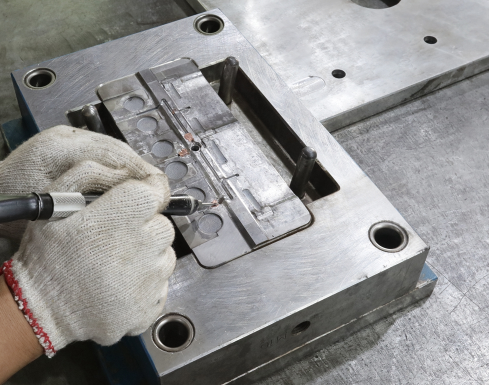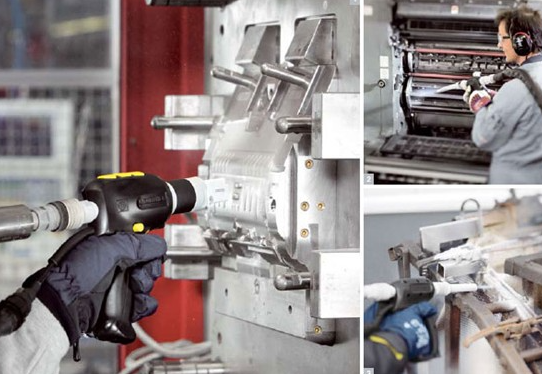
- English
- Español
- Português
- русский
- Français
- 日本語
- Deutsch
- tiếng Việt
- Italiano
- Nederlands
- ภาษาไทย
- Polski
- 한국어
- Svenska
- magyar
- Malay
- বাংলা ভাষার
- Dansk
- Suomi
- हिन्दी
- Pilipino
- Türkçe
- Gaeilge
- العربية
- Indonesia
- Norsk
- تمل
- český
- ελληνικά
- український
- Javanese
- فارسی
- தமிழ்
- తెలుగు
- नेपाली
- Burmese
- български
- ລາວ
- Latine
- Қазақша
- Euskal
- Azərbaycan
- Slovenský jazyk
- Македонски
- Lietuvos
- Eesti Keel
- Română
- Slovenski
- मराठी
- Srpski језик
Ptimization of stamping die maintenance methods
2024-08-19
Improve the maintenance method of stamping die before
The daily maintenance of stamping dies is to check the state and appearance of the dies according to the maintenance benchmark, maintenance plan and maintenance requirements, so as to detect and eliminate faults as early as possible. The process of die maintenance can be divided into three steps: ⑴Set the die maintenance benchmark; ⑵Develop an annual or monthly maintenance plan; ⑶Implement die maintenance according to the inspection form. It should be emphasized that the above benchmarks are not absolutely fixed. Each factory can revise the relevant requirements appropriately according to the implementation of die maintenance, so as to grasp the die status more timely and ensure the stability of die production.
⑴Die maintenance benchmark. The setting of die maintenance benchmark needs to comprehensively consider the working hours and die structure. At present, the common practice in the industry is to define the maintenance cycle according to the production strokes, most of which are 30,000 to 50,000 strokes for regular maintenance. Among them, the maintenance cycle of the drawing process or individual important dies will be set within 30,000 to 40,000 strokes, and other processes will be maintained within 40,000 to 50,000 strokes. The above maintenance standards are mostly used for commonly used molds. Some infrequently used molds are not produced for a long time. If the maintenance is still arranged according to the above standards, abnormal phenomena such as mold rust, air pipe aging and leakage, and mold dirtiness may occur during production. Therefore, for molds with low frequency of use, additional maintenance standards can be added, and mold maintenance can be arranged every six months.
⑵ Mold maintenance plan. In combination with mold maintenance standards and production plans, annual or monthly maintenance plans can be formulated. For molds with high frequency of use, the annual maintenance plan time is too long, and the actual production punching times of each mold are bound to be greatly different from the plan. Therefore, it is recommended to formulate a maintenance plan for the next month based on the predicted punching times of the current month to ensure that the actual maintenance cycle of the mold is consistent with the maintenance standard. At present, all industries are promoting digital production. The formulation of mold maintenance plans can also realize the system to automatically generate according to the real-time output of each product, saving man-hours and improving accuracy.
⑶ Mold maintenance requirements. The content of the mold maintenance inspection table can refer to the "cross operation" method of equipment maintenance, that is, "cleaning, lubrication, adjustment, tightening, and anti-corrosion".


a. Cleaning. Clean the inside and outside of the mold, clean the oil stains on the structural surfaces and the outside, such as cleaning and cleaning the mold surface, and cleaning the external dust to ensure that the surface quality of the parts meets the requirements during mold production;
b. Lubrication. Lubricating surfaces such as mold guides and guide mechanisms should be replaced with lubricants regularly. For example, wipe off the oil stains on the sliding surface during maintenance, and add new lubricants to ensure smooth movement of each mechanism;
c. Adjustment. Adjust the clearance of each moving part and matching part on the mold to ensure stable production quality. For example, for the detection of the cutting edge penetration, refer to the benchmark requirements of 2 to 5mm, and repair the cutting edge that does not meet the penetration in time to ensure the stability of mold production;
d. Tightening. After a certain number of mold production, it is not ruled out that some bolts are loose due to production vibration. During maintenance, the mold insert bolts need to be re-tightened
e. Anti-corrosion. Check the internal and external appearance of the mold to confirm whether there is any damage/rust/crack on the mold surface, especially the long-term stress-bearing positions on the mold. Perform visual inspection during maintenance and arrange mold flaw detection if necessary.
In addition to the items related to the "cross operation" method, mold inspection will also add some other inspection items, such as waste troughs, electroplated chrome layers, springs, polyurethane, identification plates, etc. Based on the above inspection contents, a universal mold inspection form can be formulated. During maintenance, inspections must be carried out as required and the results must be filled in. If any abnormality is found during maintenance, it should be handled differently according to the severity of the problem. The main treatment methods are: ① If it can be solved through simple adjustment or polishing, the inspection personnel shall handle it by themselves and fill in the countermeasure process on the inspection form; ② For problems that are difficult to repair and have a long improvement cycle, the inspection personnel shall report them step by step, and the technicians shall confirm the improvement plan and schedule to eliminate major hidden dangers.
Current stamping die maintenance problems
The universal mold maintenance template cannot adapt to all situations. Due to the different mold structures, the potential risks of the mold cannot be completely eliminated according to the inspection table. At the same time, some consumables on the mold (such as springs and polyurethane) may appear abnormal in advance, resulting in poor quality of parts or even a major risk of damaging the mold if they are only replaced after abnormalities are found during maintenance. Therefore, referring to the way of car maintenance - the maintenance items are different for different mileages, the content of the mold maintenance inspection table is revised, and some mold spare parts are replaced in advance in combination with the number of production punches and the theoretical life of consumables, so as to optimize the maintenance requirements of the mold.
Improved stamping mold maintenance method
Refine inspection items
The inspection items of the original maintenance method are applicable to all molds, but there are limitations. In fact, due to different functions, the mold parts of each process are very different. For example, the drawing process consists of upper and lower die seats, profiles, positioning, etc., and the trimming process consists of upper and lower die seats, pressure plates, spring polyurethane/punch blades, etc. If the universal version is used, some molds will not have relevant inspection items, resulting in the items that need to be checked not being on the inspection table. Therefore, different inspection tables need to be formulated for different mold structures. However, if all mold parts are inspected and maintained every time maintenance is performed, the maintenance hours will be greatly increased. Therefore, the maintenance hours and the structural characteristics of each process are comprehensively considered, and different inspection items are checked at different frequencies in combination with past experience and design requirements. The revised inspection table sets different inspection contents according to different punching times, such as 40,000 times, 80,000 times, 120,000 times, etc.
Similarly, specific inspection tables for different molds are formulated, and the inspection contents are refined. Under the premise of ensuring that the working hours are met, the mold maintenance effect can be better improved, and mold hidden dangers can be discovered and handled in time. After the detailed inspection table, if there are additional inspection items during the subsequent mold maintenance process, the inspection table of the mold can be revised at any time. If a mold has a crack defect, it is necessary to regularly track the crack expansion. The mold maintenance inspection table can be revised, and the crack inspection content can be added, which reduces the special tracking and lifting hours for the crack defect, saves special maintenance hours, and improves management efficiency.
Optimize the inspection requirements for consumables
The original maintenance method for consumables (springs, polyurethane, etc.) on the mold is to replace them only when abnormalities are found (such as spring breakage, polyurethane aging or permanent deformation). In the actual mass production process, spring breakage or polyurethane aging damage is often discovered only when quality abnormalities occur during the mass production process. At this time, the mold is arranged to withdraw the line to replace the spring and polyurethane. This situation is actually post-maintenance, which poses a safety hazard of mold damage. In fact, springs and polyurethanes have corresponding theoretical service lives according to different compression rates. The mold inspection table can be revised based on the actual compression rates and corresponding theoretical service lives of each mold spring and polyurethane, and springs and polyurethanes can be replaced regularly. For example: ① The spring model used on a certain mold is xxM, with a compression rate of 30%, corresponding to a theoretical service life of 300,000 strokes. Therefore, the inspection table requires that the spring of this model be replaced in advance when the mold is maintained for 240,000 strokes; ② The compression rate of the polyurethane on the mold is 25%, corresponding to a theoretical service life of 500,000 strokes. Considering that the service life of polyurethane is affected by both the compression rate and the use environment (oil pollution will cause polyurethane to age faster), the inspection table requires that the polyurethane of the mold be replaced when it is maintained for 240,000 strokes. Of course, early replacement of mold consumables will increase maintenance costs, and comprehensive considerations are required when revising the inspection table.
Finally
The purpose of mold maintenance is to discover and eliminate mold hidden dangers or defective items in advance through regular inspections, and minimize mold online failures or offline maintenance time. Based on the problems existing in the mold mass production maintenance process, this article optimizes the mold maintenance method, plays the role of mold preventive maintenance, strives to reduce mold failures, and improves production utilization.



